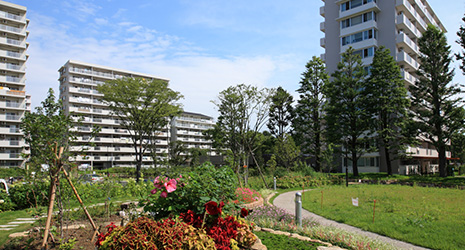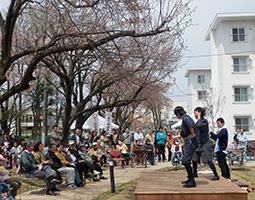INDEX
- English
- 日本語

Tamadaira-no-Mori - English
- 日本語

Tamadaira Apartment Complex before reconstruction

Tamadaira-no-Mori fosters interactions between local residents 
Shared housing with vegetable gardens, AURA 243
July 2020
An Apartment Complex Reborn

At the Tamadaira Apartment Complex in the bed town of Hino City, Tokyo, reconstruction has provided an opportunity for new community development. We are seeing the birth of a lively neighborhood where everyone from university students to young parents and elderly people interact.

During the period of rapid economic growth from the 1950s to the mid-1960s, there was a serious labor shortage in Japanese cities and the solution was gathering many young people from the countryside. In order to provide them with housing, the Japan Housing Corporation (now the Urban Renaissance Agency [UR]) built a large number of apartment complexes side by side on one plot or block. Although compact, the apartments in these complexes were equipped with what was the latest in flush toilets, bathtubs, eat-in kitchens and verandas, and so became popular as they offered a new way of life.
One of them was the Tamadaira Apartment Complex that was completed in 1958. It is said that the applicant-to-tenant ratio was several hundreds to 1, because the complex was conveniently located for commuters being little more than 30 minutes by train from Shinjuku Station and within walking distance of the nearest station (Toyoda), as well as being rich in green areas. However, as the times changed, the residential living area and facilities stopped meeting the needs of the times, and in 1996, a plan was launched for large-scale reconstruction and new community development.
Yet the road to ensure consensus for the reconstruction plan among tenants was not a smooth one. Hamaguchi Takahiro at the UR explains it as follows.
“Most tenants were very attached to the apartment complex and considered it their ‘lifetime home.’ Because of this, we started a study group for Hino City, the apartment complex residents’ association and the UR to discuss all themes relevant to the reconstruction project. At these study meetings, we listened to the opinions of all residents and advanced the project while also working toward building a consensus.”
As a result, the 247 buildings on a site of 290,000 m2 were consolidated into high-rises as 30 buildings on a site of 110,000 m2. A plan was launched to attract libraries, nursery schools, and other public facilities as well as large commercial facilities and private housing companies to the land that was opened up through the vertical expansion. In 2008, twelve years after the plan was started, Tamadaira Apartment Complex was reborn as Tamadaira-no-Mori (Tamadaira Forest), thereby concluding the reconstruction to new housing.
At the same time, a renaissance plan was also implemented to make effective use of the existing buildings, not just as an approach to reconstruction but also from a perspective of sustainable community building.

A major feature of this plan is three facilities spread out across a total of five buildings, collectively called Tama Musubi Terrace, which embodies the concept of diverse human interactions.
One facility is two buildings that function as a share house complex. The first floor is a common area with kitchen, lounge, shower rooms, and other facilities as well as a wooden terrace that can be used for events and parties. One building is used as a student dormitory for nearby universities while applications for the other building were open to everyone, although the majority of residents appear to be university students and young people.
The second facility is shared housing with vegetable gardens. The gardens are adjacent to the residential building and have work huts and resting areas, allowing residents to enjoy vegetable gardening in their daily lives. Many people living nearby also come to use the gardens.
The third is rental housing exclusively for elderly people, with lunch and dinner provided at reasonable prices in the adjoining restaurant, which is open not just to residents but to everyone. Moreover, events like handbell and chorus practice are held to gather people from all generations and provide the elderly residents with opportunities to meet each other.

In addition, there is a newly built block called Te to Te Terrace on the premises, which houses a social education center run by Hino City, a nursery school, a special nursing home for elderly people, a hospital with rehabilitation facilities, a sports club, and other facilities. It has created an attractive community where people from all generations interact. Children at the nursery school visit the hospital while the sports club works with the neighboring hospital to provide exercise guidance.
Hamaguchi explains, “During the period of rapid economic growth, the goal of apartment complexes was just ‘to provide housing in large quantity.’ As time went by, our aspiration became ‘housing and community development where all generations can continue to live active lives.’ Our hope is to continue to provide new community building through the revival of apartment complexes.”
Half a century onward, the apartment complex that once was the starting point of a new way of living is on its way to become a new starting point once again.

